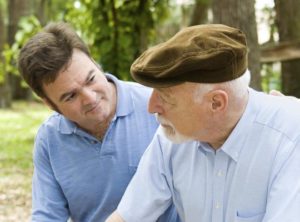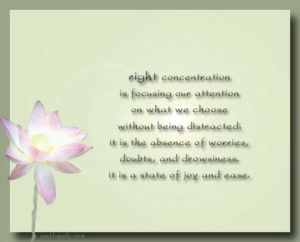
By John M. de Castro, Ph.D.
“Very often, depression can be about the past, ruminating over and over about losses or other terrible things that happened in the past. Anxiety, meanwhile, very often involves ruminating about terrible things that you’re afraid are going to happen in the future. But in the present, very often, there’s actually nothing terrible going on, and the act of recognizing that can be helpful.” – Anthony King
Experiencing trauma is quite common. It has been estimated that 60% of men and 50% of women will experience a significant traumatic event during their lifetime. But, only a fraction will develop Post-Traumatic Stress Disorder (PTSD). But this still results in a frightening number of people with 7%-8% of the population developing PTSD at some point in their life. For military personnel it’s much more likely for PTSD to develop with about 11%-20% of those who have served in a war zone developing PTSD.
PTSD involves a number of troubling symptoms including reliving the event with the same fear and horror in nightmares or with a flashback (Experiencing). PTSD sufferers avoid situations that remind them of the event this may include crowds, driving, movies, etc. and may avoid seeking help because it keeps them from having to think or talk about the event (Avoidance). They often experience negative changes in beliefs and feelings including difficulty experiencing positive or loving feelings toward other people (Emotional Numbing), avoiding relationships, memory difficulties, or see the world as dangerous and no one can be trusted. Sufferers may feel hyperarousal, feeling keyed up and jittery, or always alert and on the lookout for danger (Hyperarousal). They may experience sudden anger or irritability, may have a hard time sleeping or concentrating, may be startled by a loud noise or surprise.
Obviously, these are troubling symptoms that need to be addressed. There are a number of therapies that have been developed to treat PTSD. One of which, mindfulness training has been found to be particularly effective. It is important to further investigate mindfulness relationships to PTSD symptoms in order to optimize treatment. In today’s Research News article “Changes in Mindfulness and Posttraumatic Stress Disorder Symptoms Among Veterans Enrolled in Mindfulness-Based Stress Reduction.” See:
or below or view the full text of the study at:
http://www.ncbi.nlm.nih.gov/pubmed/27152480
Stephenson and colleagues investigated changes in mindfulness accompanying Mindfulness-Based Stress Reduction (MBSR) treatment for Posttraumatic Stress Disorder (PTSD) in veterans. They pooled the data from four trials of MBSR for PTSD, measuring changes in mindfulness, PTSD symptoms, and depression over the course of treatment.
They found that changes in mindfulness were highly related to improvement in PTSD symptoms and depression, with larger increases in mindfulness associated with larger improvements in all PTSD symptoms and also in depression. Two facets of mindfulness, Acting with Awareness and Non-reactivity particularly were strongly associated with improvements. On the other hand, increases in the Observing facet of mindfulness were sometimes associated with worsening symptoms, while the Describing and Non-judging facets were not significantly associated. The greatest changes in PTSD symptoms associated with mindfulness were in the Hyperarousal, followed by Emotional Numbing, Re-Experiencing, and Avoidance symptom clusters.
These are interesting results and help to clarify the nature of mindfulness effects on PTSD symptoms. The actual reasons for the associations are not known. But, some speculative hypotheses can be postulated. The fact that Non-reactivity was highly associated seems intuitively obvious as being overly reactive to the stimuli and events around them is a key symptom of PTSD. In addition, by Acting with Awareness the veterans are engaged in activities while they are more focused on the present moment. Hence, they would be less likely to bring in the past events, particularly traumatic events, into their present moment experience. A worsening of PTSD symptoms was associated with larger change in the Observing facet. By heightening awareness of their internal state, the veterans may become even more sensitive to their troubling emotional responses resulting in heightened anxiety and fear.
Regardless of these speculations, it is clear that improvements in PTSD symptoms with veterans are associated with heightened mindfulness. This further supports the application of MBSR for the treatment of PTSD in veterans. This treatment can be of great help in relieving the torment that is called PTSD, allowing the veterans to resume more normal lives.
So, improve PTSD with mindfulness.
“Part of the psychological process of PTSD often includes avoidance and suppression of painful emotions and memories, which allows symptoms of the disorder to continue,” King says. “Through the mindfulness intervention, however, we found that many of our patients were able to stop this pattern of avoidance and see an improvement in their symptoms.” – Anthony King
CMCS – Center for Mindfulness and Contemplative Studies
This and other Contemplative Studies posts are available on Google+ https://plus.google.com/106784388191201299496/posts
Study Summary
Stephenson, K. R., Simpson, T. L., Martinez, M. E. and Kearney, D. J. (2016), Changes in Mindfulness and Posttraumatic Stress Disorder Symptoms Among Veterans Enrolled in Mindfulness-Based Stress Reduction. J. Clin. Psychol.. doi: 10.1002/jclp.22323
Abstract
OBJECTIVES: The current study assessed associations between changes in 5 facets of mindfulness (Acting With Awareness, Observing, Describing, Non-Reactivity, and Nonjudgment) and changes in 4 posttraumatic stress disorder (PTSD) symptom clusters (Re-Experiencing, Avoidance, Emotional Numbing, and Hyperarousal symptoms) among veterans participating in mindfulness-based stress reduction (MBSR).
METHOD: Secondary analyses were performed with a combined data set consisting of 2 published and 2 unpublished trials of MBSR conducted at a large Veterans Affairs hospital. The combined sample included 113 veterans enrolled in MBSR who screened positive for PTSD and completed measures of mindfulness and PTSD symptoms before and after the 8-week intervention.
RESULTS: Increases in mindfulness were significantly associated with reduced PTSD symptoms. Increases in Acting With Awareness and Non-Reactivity were the facets of mindfulness most strongly and consistently associated with reduced PTSD symptoms. Increases in mindfulness were most strongly related to decreases in Hyperarousal and Emotional Numbing.
CONCLUSIONS: These results extend previous research, provide preliminary support for changes in mindfulness as a viable mechanism of treatment, and have a number of potential practical and theoretical implications.
http://www.ncbi.nlm.nih.gov/pubmed/27152480








